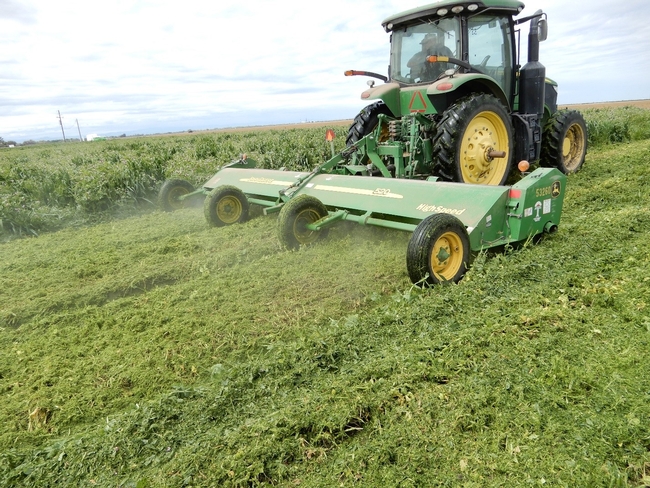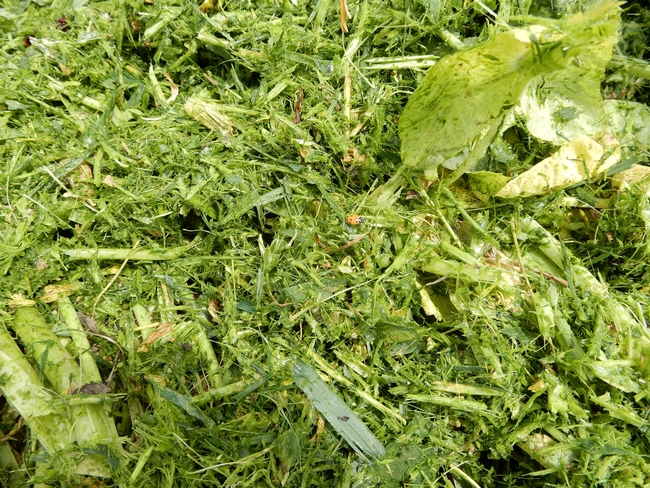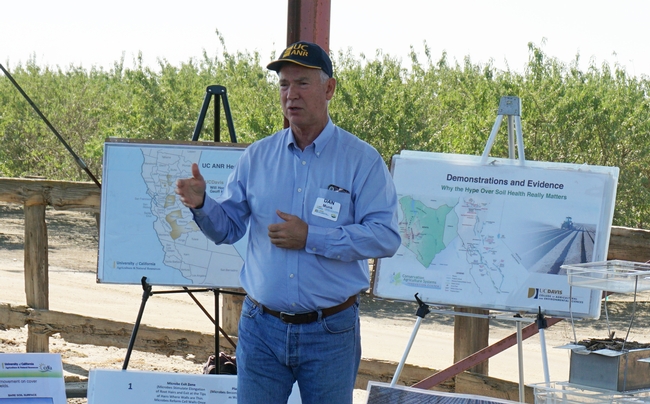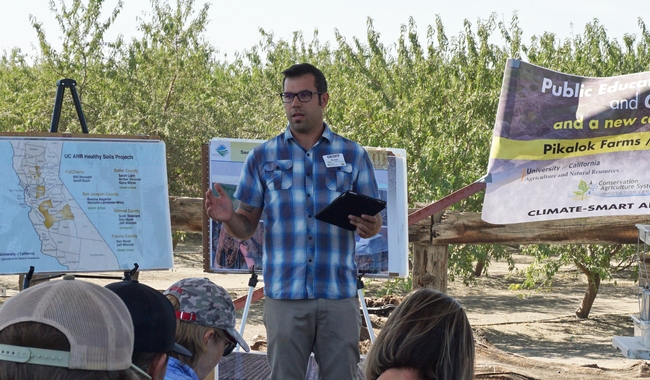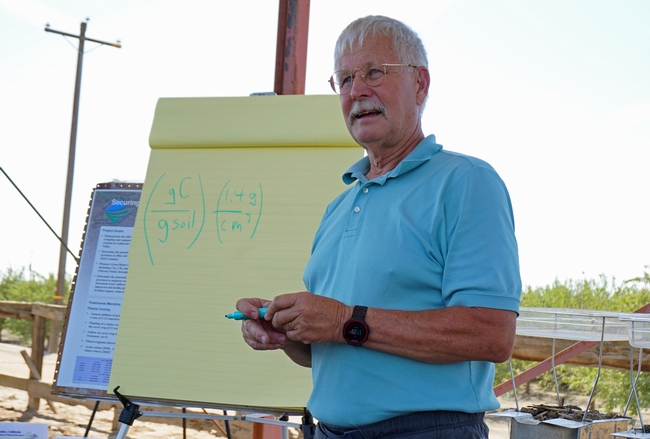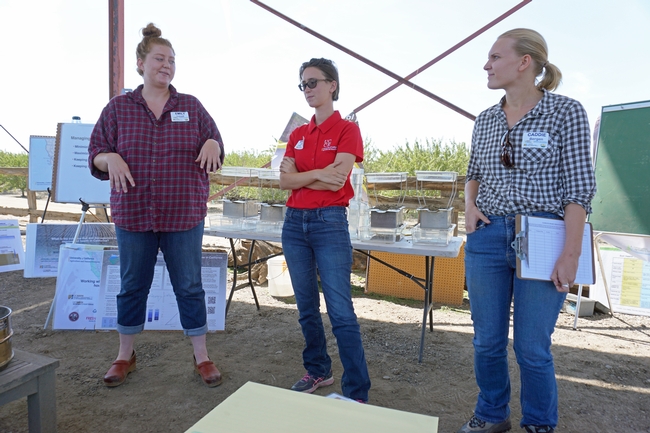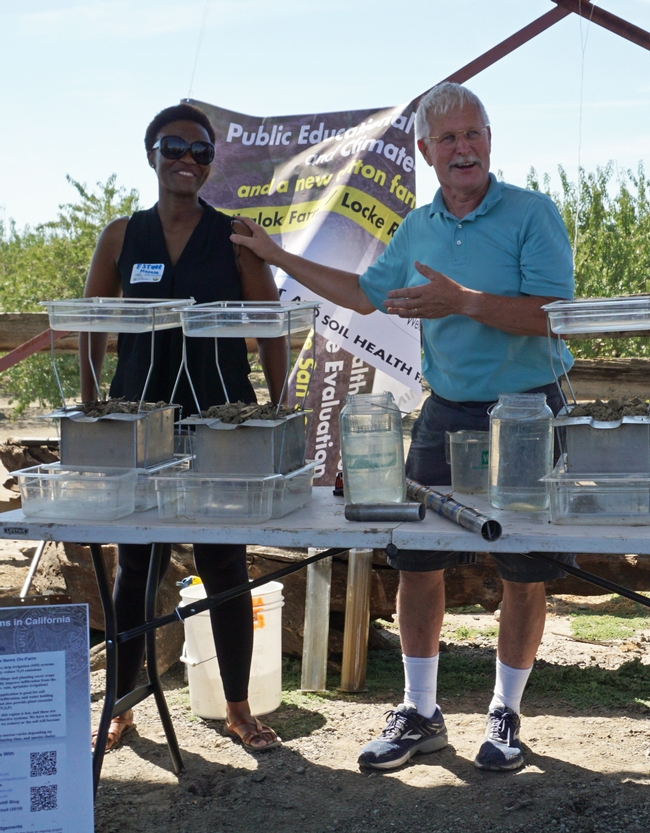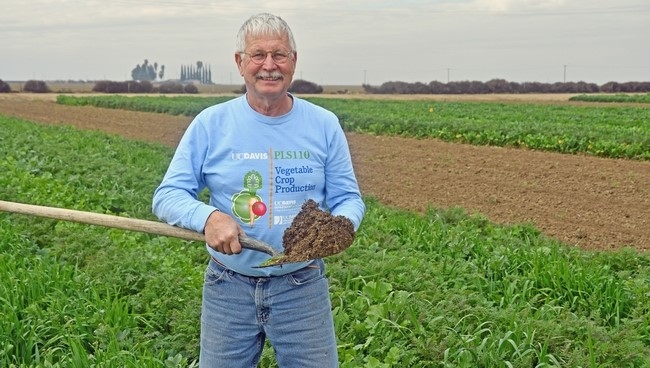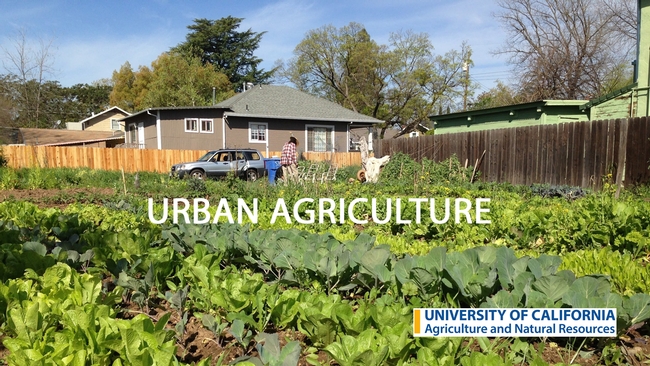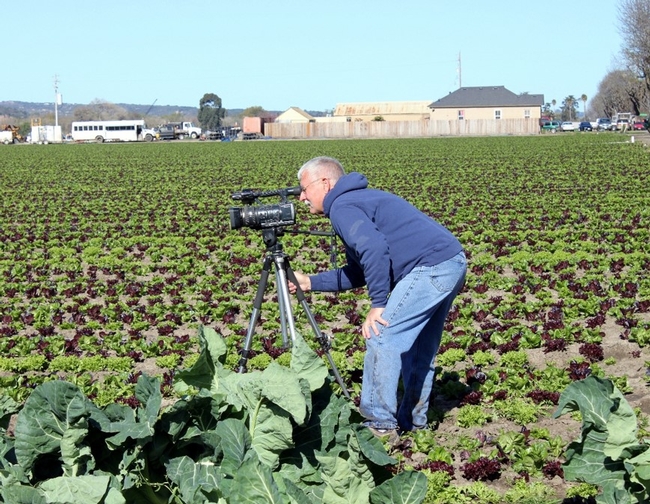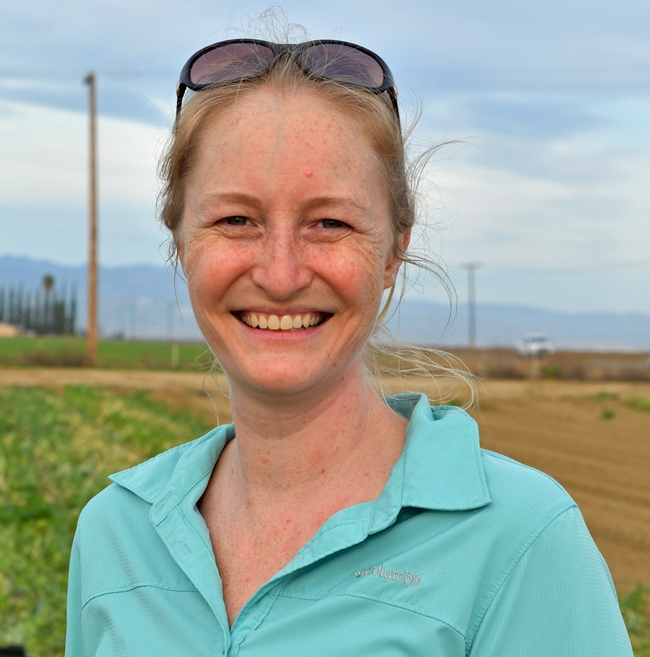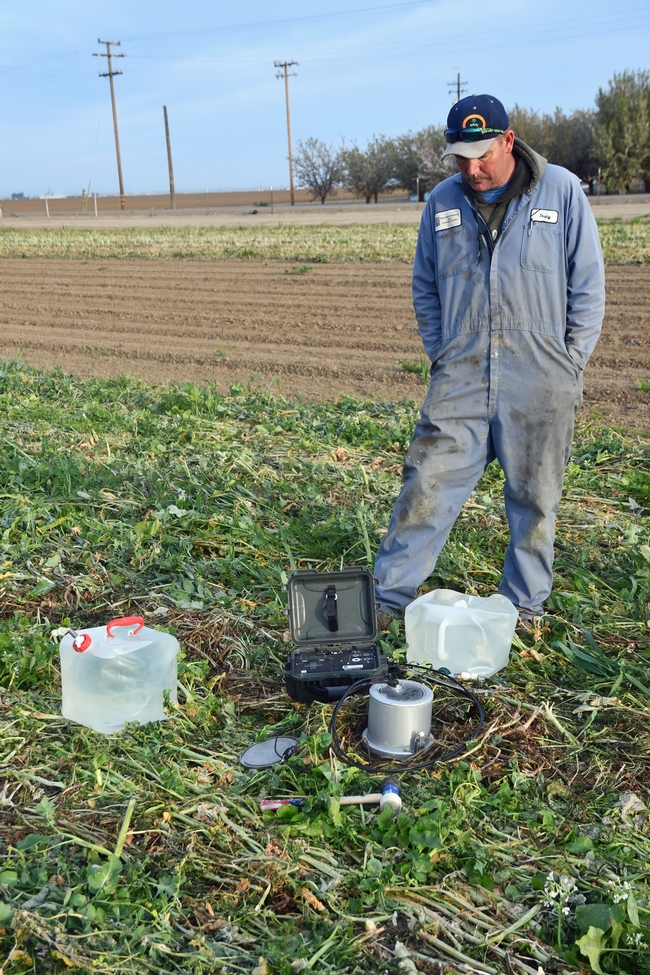Posts Tagged: Jeff Mitchell
Soil health practices show economic and ecological benefits, say farmers
A group of California organic farmers is sharing information about their efforts to combine reduced tillage with the use of cover crops, which they have been planting on their vegetable farms for decades to protect soil while adding carbon and diversity to their production systems.
“Every one of the pioneering farmers has seen tremendous benefits from the practices,” said Jeff Mitchell, UC Cooperative Extension vegetable crops specialist. “These are the very growing practices that we have demonstrated over two decades of research to benefit soil health, environmental conservation and the bottom line on plots near Five Points in Fresno County.”
The organic farmer research project is funded with a Natural Resources Conservation Service Conservation Innovation Grant (CIG) and aims to develop crop production system alternatives for vegetable crops. The farmers are seeing evidence of the ecological benefits, and also benefits that promote the public good.
“Consumers prefer food that is grown in ways that improve soil health as well as environmental health and human health,” Mitchell said. “Farmers must not become obsolete by ignoring ever-evolving buyer demands and environmental imperatives. Make changes, or you'll lose markets.”
The need for California farmers to adjust to changing times was to have been part of the dialogue at a public field day in March at Teixeira & Sons Farm in Firebaugh. It was postponed due to COVID-19 concerns. The event was to showcase Mitchell's data and the experiences of long-time cover crop farmer John Teixeira of Firebaugh.
Teixeira began cover cropping 30 years ago in one of his organic fields. He wanted to build fertility, organic matter and water holding capacity in the soil. Ever since, he's been growing cover crops ahead of tomatoes and several other commodities. This past winter, he grew a mixture of common, hairy and purple vetch, white oats, biomaster peas and bell beans. Teixeira estimates that it provided over 5,000 pounds per acre of dry biomass, which is supporting his 2020 tomato crop with elevated biological activity in the soil.
Mitchell's study in Five Points has tracked impacts of winter cover cropping coupled with no-till since 1999. Over the 21 years, some 37 tons of organic matter, or about 15 tons of carbon, have been added to the soil. These inputs averaged about 3,700 pounds per acre of organic matter, or 0.8 tons of carbon annually. Year-to-year variability has been high, ranging from 8,800 pounds in 2000 when supplemented by irrigation, to 54 pounds in 2007 when, as in most years, the cover crops were grown with rainfall only. Cover crops were typically seeded by Nov. 15 each fall and terminated around March 15.
Several key soil-health indicators improved over the years, including aggregation (or soil structure), porosity and water-holding capacity. Work at the Five Points site conducted by UC Merced professor Teamrat Ghezzehei and Ph.D. student Samuel Araya, has shown 20% higher water-holding capacity in the system with cover crops and no-till compared to the standard bare system.
Earlier results from the study field have shown that when the cover crop and other crop residues are converted to a mulch and left on the soil surface, as much as five inches of water that would normally evaporate during a typical summer crop period stays in the soil.
Mitchell is coordinating the group of organic farmers who are conducting cover crop, tillage and mulch experiments. The farmers cultivate vegetables up and down the Central Valley from Meridian and Guinda in the north, to Dixon, Hollister, Madera, Five Points and Buttonwillow in the south.
“They are an incredible group of people,” Mitchell said. “They have taken soil, farm and human health goals to dramatically important lengths.”
As organic farmers, they have always been in the forefront of soil care and attention to soil biology, Mitchell said, but they're now working together to implement such innovations as virtually year-round soil cover, reduced disturbance tillage, and integration of grazing animals into their fields. Their objective is to enhance the health of their soils, the health of their farms, and the quality of the vegetables that they produce.
Tom Willey, one of the project's farmers from Madera, puts it this way, “What we're attempting to do is up our game on natural systems mimicry on our farms, break through the barrier of over-dependence on tillage in organic systems.”
Eric Brennan, a USDA Agricultural Research Services organic systems horticulturist in Salinas, and integral partner in the effort, has studied cover crops in the Salinas Valley.
“Cover cropping regularly, every winter if possible, is one of the ‘lowest-hanging fruit' practices that vegetable farmers can use to improve soil quality and nutrient management in their production,” Brennan said.
Mitchell believes it's time for broad adoption of practices to promote soil health.
“Everyone used to talk about ‘barriers to adoption' when it came to cover crops. Now the question will more aptly be, ‘What happened to those folks who didn't change and adopt?'” Mitchell said.
UC Cooperative Extension encourages adoption of healthy soil techniques on California farms
Before the San Joaquin Valley was cultivated, vast grasslands stretched from the Sierra to the Coast Range with soil that contained significant organic matter – a diversity of live and dead plant material and microbes that are key to soil health.
Tilling the soil for farming exposed it to air and allowed the organic matter to oxidize, releasing greenhouse gasses and reducing organic matter to about 1 percent of soil volume. UC Agriculture and Natural Resources research has shown that soils with low organic matter inhibit water infiltration, nutrient cycling, biological diversity and carbon sequestration.
But techniques have been developed to return soil to a more natural, more healthful state.
Farmers, students, researchers and community educators gathered at Gary and Mari Martin's farm in Mendota Sept. 13 to share ideas and strategies for extending information to the greater farming community that will increase adoption of conservation agricultural practices that reduce greenhouse gas emissions from farmland and at the same time improve soil health.
For two years, the Martins have opened their farm to research led by UC Cooperative Extension cropping systems specialist Jeff Mitchell. For the project, UC Davis doctoral student Geoff Koch is studying soil health indicators and greenhouse gas emissions at the Martins' farm and at the UC West Side Research and Extension Center, where plots have been cultivated using traditional methods and conservation practices side by side for 20 years.
Expanding the use of conservation agricultural practices is not limited to Central California.
“Our government endorses these principles of soil health,” Mitchell said. “It's part of a national campaign aimed at improving the health of our country's soils.”
The USDA Natural Resources Conservation Service has four recommendations for the agricultural industry to improve soil health:
- Minimize soil disturbance
- Emphasize biodiversity
- Keep living roots in the soil
- Keep soil covered with plants and plant residues at all times
Employing these techniques in the research project at the West Side Research and Extension Center for 20 years has shown that annual cover cropping has added 37 tons of organic matter per acre to the soil, captured 15 tons of carbon per acre and used only about 12 inches of water per acre.
At the workshop, three University of California Cooperative Extension (UCCE) climate-smart educators invited farmers to contact them for assistance in applying for state funds they can use to implement climate-smart farming practices.
Climate-smart educator Emily Lovell said the California Department of Food and Agriculture's State Water Efficiency and Enhancement Program (SWEEP) pays up to $100,000 to improve irrigation efficiency, reduce water use and reduce greenhouse gas emissions. Farmers can use the funding to, for example, convert to drip irrigation systems, install moisture sensors or set up a weather station.
Lovell said it is a competitive and complex application process.
“We help with the applications,” she said.
Climate-smart educator Shulamit Shroder described the CDFA's Healthy Soils Program (HSP), which incentivizes farmers with up to $75,000 to implement such practices as planting cover crops, using no-till or reduced tillage techniques, applying mulch or compost, or planting hedgerows. The applications are due in February 2020.
For more details on the CDFA Climate Smart Agriculture programs and for technical assistance on applying, contact a local UCCE climate-smart educator.
The cover cropped-field is the 'real disruptor'
KQED reporter Mark Schapiro discovered a "center of insurrection" at the UC West Side Research and Extension Center in Five Points, where UC Cooperative Extension cropping systems specialist Jeff Mitchell has been building soil on a research plot for 20 years.
Schapiro's story was part of a series titled "Reckoning in the Central Valley," a collaboration between Bay Nature magazine and KQED Science examining how climate change is exposing the vulnerabilities of California agriculture.
In the Central Valley, climate change is disrupting the predictability that is key to maintaining a profitable industrial agriculture system. Mitchell believes that employing practices that build soil - such as reducing or eliminating tillage and planting cover crops - will help farmers ride the wave of climate change.
It's that cover-cropped field “that is the real disruptor here," Mitchell said.
The soil in test plots where cover crops were grown are loaded with far more organic matter than soil in fields where cover crops were not grown. The organic matter improves water absorption, making the land more resilient to drier conditions. Fields with cover crops also sequester carbon and produce crops that may be more nutritious.
“What you see in Five Points,” said Daphne Miller, a physician who studies the links between the health of the foods we eat and the soil in which they're grown, “is that the plots with the greatest diversity of cover crops had the most diverse microbiome in the soil.”
New video series to spark interest in vegetable production of the future
A 26-episode weekly video series will debut May 13 on YouTube to help train the next generation of vegetable crop workers and increase their use of effective stewardship practices in vegetable production.
Projections for near-future retirements of people working in California's agricultural production, marketing and post-harvest handling sectors indicate severe re-staffing needs in the coming years. Technological advances have reduced manual labor in agriculture, but increased the need for skilled labor to maintain the sustainability of the vegetable industry.
“We already see it happening,” said Jeff Mitchell, UC Cooperative Extension vegetable crops specialist. “Robotic machines are now used for lettuce thinning in Salinas, but these technologies must be serviced by an educated workforce with knowledge in both mechanics and science.”
Mitchell assembled a team of professors from California's public universities with agricultural programs – UC Davis, Chico State, Fresno State and CalPoly San Luis Obispo - to pull together a series of videos designed to spark the interest and begin training future farmers and ag workers in sound agronomic, economic and environmental stewardship skills. The team received financial support from the California Department of Food and Agriculture Specialty Crops Block Grant Program.
“We know that maintaining California's leading role in producing abundant, safe vegetables is critical not only to Americans' health, but also to the state's economy,” Mitchell said.
The video series is offered on the UC Agriculture and Natural Resources (UC ANR) YouTube page on a playlist titled “Training of a New Generation of California Vegetable Producers.” UC ANR is the outreach arm of the University of California which, among other services, provides agricultural research, teaching and advising in all California counties.
Each Monday morning from May 13 through Nov. 4, a new video will premiere in the playlist. The video length ranges from 47 minutes to 7 minutes. The videos will also be made available to high school and college ag professors to use in the classroom.
“We believe that this series of videos on vegetable production will have broad interest beyond the classrooms,” Mitchell said. “The agricultural industry, students in other parts of the United States and the world, and the broader public all have an interest in understanding how the vegetables we eat are produced at the ever-increasing scale at which they are needed.”
The videos depict state-of-the-art technologies and techniques that are in use in many production regions of California today, vegetable farming systems used in other parts of the world, and increasingly popular cottage farming systems that are popping up in urban areas for easy access to healthful foods.
To receive a notification of each video premiere, follow the UC ANR Twitter feed at http://twitter.com/UCANR or set a reminder by visiting the playlist on YouTube.
Soil Health Institute scientist visits UC’s long-term soil health experiment in Five Points
Shannon Cappellazzi, one of six project scientists involved in an expansive Soil Health Institute (SHI) initiative, visited the UC West Side Research and Extension Center in March to take soil samples from research plots managed for 20 years with soil building practices.
The West Side research plots are one of 120 locations in Canada, the United States and Mexico where the SHI scientists are collecting data to evaluate soil health indicators at a continental scale.
The initiative will identify acceptable soil health measurements and standards, as well as launch a comprehensive evaluation program that relates soil health to productivity, economic and environmental outcomes. Cappellazzi is project scientist for the Western U.S. and coordinates the soil health team's pastures and rangeland research.
“Our project at West Side started in 1999 and is a unique research resource in California because of its dedication to reduced soil disturbance and soil biodiversity in food production systems,” said Jeff Mitchell, UC Cooperative Extension specialist and leader of UC's Conservation Agriculture Systems Innovation.
Since it was established, the research plots have been managed in an annual rotation of cotton, processing tomatoes and more recently sorghum, garbanzo beans and melons, under four different treatments: no-tilled plus cover crops, no-tilled with no cover crops, conventionally tilled with cover crops and conventionally tilled without cover crops.
“There are few long-term study sites in California where this combination of core principles that underlie soil health have been applied for a long time frame like we have here at the West Side REC,” Mitchell said. “These principles include reducing disturbance of the soil, maintaining cover over the soil through the use of residues and cover crops, and accentuating diversity in crops and soil biology.”
“Our research project at the West Side REC has enabled scientists to reach many conclusions about soil health in the past. But this very exhaustive sampling by the Soil Health Institute is perhaps the most comprehensive battery of tests that have ever been performed on any study site in the San Joaquin Valley to date,” Mitchell said.
The research initiative is funded with a $9.4 million grant to the Soil Health Institute, the Soil Health Partnership and the Nature Conservancy to improve soil health and support positive economic and environmental outcomes for American farmers and ranchers.
The goal of this project is to support research and education that accelerates adoption and benefits of soil health management systems nationally. Farming practices that improve soil health can increase profitability while protecting natural resources like air and water for communities.
For more information about the sample collection process at the West Side REC, view a 14-minute video at https://youtu.be/WSNg6rJdvvE


